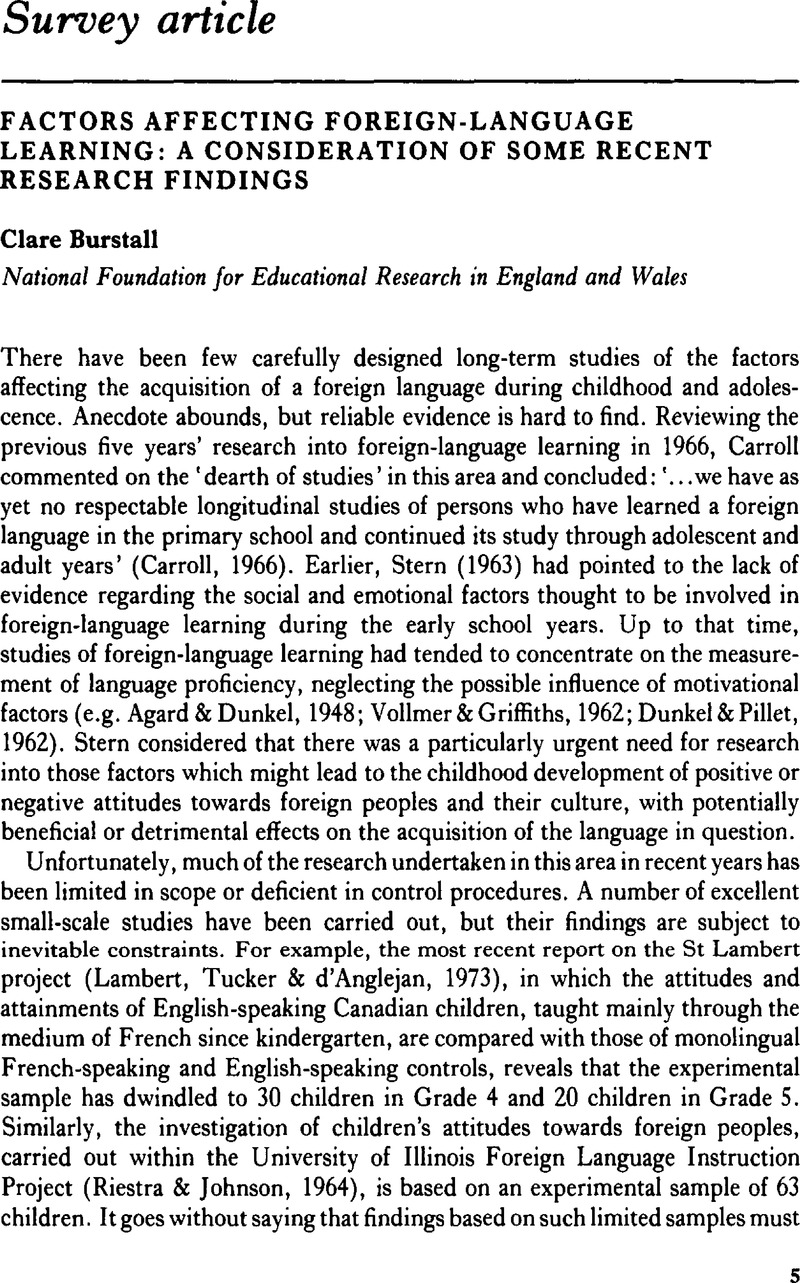Crossref Citations
This article has been cited by the following publications. This list is generated based on data provided by Crossref.
Barik, Henri C.
and
Swain, Merrill
1977.
French Immersion in Canada.
ITL - International Journal of Applied Linguistics,
Vol. 36,
Issue. ,
p.
45.
Stern, H. H.
and
Weinrib, Alice
1977.
Foreign Languages for Younger Children: Trends and Assessment.
Language Teaching & Linguistics: Abstracts,
Vol. 10,
Issue. 1,
p.
5.
Tosi, Arturo
1979.
Mother-Tongue Teaching for the Children of Migrants.
Language Teaching,
Vol. 12,
Issue. 3-4,
p.
213.
Ekstrand, Lars Henric
1980.
Sex differences in second language learning? Empirical studies and a discussion of related findings.
Applied Psychology,
Vol. 29,
Issue. 1-2,
p.
205.
Ladousse, Gillian Porter
1982.
From needs to wants: Motivation and the language learner.
System,
Vol. 10,
Issue. 1,
p.
29.
Titone, Renzo
1983.
The Sociogenesis of Language and Human Conduct.
p.
273.
Skehan, Peter
1991.
Individual Differences in Second Language Learning.
Studies in Second Language Acquisition,
Vol. 13,
Issue. 2,
p.
275.
Oladejo, J.A.
1992.
Studies in Language Learning in Large Classes: A Critical Appraisal.
RELC Journal,
Vol. 23,
Issue. 1,
p.
48.
Mägiste, Edith
1992.
Second language learning in elementary and high school students.
European Journal of Cognitive Psychology,
Vol. 4,
Issue. 4,
p.
355.
Jones, Francis R.
1992.
A language-teaching machine: Input, uptake and output in the communicative classroom.
System,
Vol. 20,
Issue. 2,
p.
133.
Lynn, Richard
and
Wilson, R. Graham
1992.
Foreign language ability and its relation to general intelligence.
Research in Education,
Vol. 47,
Issue. 1,
p.
40.
Sparks, Richard L.
and
Ganschow, Leonore
1993.
The effects of multisensory structured language instruction on native language and foreign language aptitude skills of at-risk high school foreign language learners: A replication and follow-up study.
Annals of Dyslexia,
Vol. 43,
Issue. 1,
p.
194.
Hood, Philip
1994.
Primary foreign languages – the integration model: some parameters for research.
The Curriculum Journal,
Vol. 5,
Issue. 2,
p.
235.
Cenoz, Jasone
and
Valencia, José Francisco
1995.
El papel del bilingüismo en la adquisición de una lengua extranjera: el caso del aprendizaje del inglés en Gipuzkoa.
Infancia y Aprendizaje,
Vol. 18,
Issue. 72,
p.
127.
Sparks, Richard L.
and
Ganschow, Leonore
1995.
Parent Perceptions in the Screening of Performance in Foreign Language Courses.
Foreign Language Annals,
Vol. 28,
Issue. 3,
p.
371.
KUHLEMEIER, HANS
VAN DEN BERGH, HUUB
and
MELSE, LEIJN
1996.
Attitudes and Achievements in the First Year of German Language Instruction in Dutch Secondary Education.
The Modern Language Journal,
Vol. 80,
Issue. 4,
p.
494.
Brown, Annie
Hill, Kathryn
and
Iwashita, Noriko
2000.
Is learner progress in lote learning comparable across languages?.
Australian Review of Applied Linguistics,
Vol. 23,
Issue. 2,
p.
35.
Lazarova-Nikoska, Ana
2004.
Différence de Rythme : l’Adulte acquiert-t-il plus rapidement que l’enfant ?.
Acquisition et interaction en langue étrangère,
p.
13.
Cohen, Debra
and
Berkowitz, Nancy
2005.
Gender and the Language of Religion.
p.
240.
García Mayo, María del Pilar
Ibarrola, Amparo Lázaro
and
Liceras, Juana M.
2005.
Placeholders in the English Interlanguage of Bilingual (Basque/Spanish) Children.
Language Learning,
Vol. 55,
Issue. 3,
p.
445.





